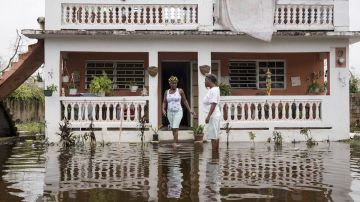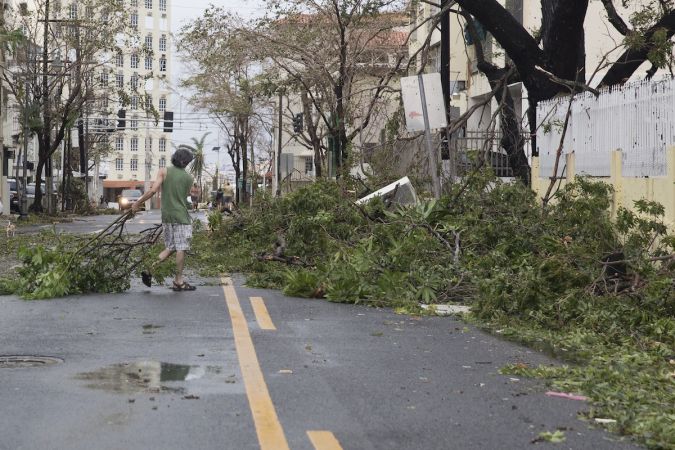As the Federal Government’s Relief Efforts Fail, the Puerto Rican Diaspora Steps Up

Residents wade through flood waters at their home days after Hurricane Maria made landfall, on September 22, 2017 in Loiza, Puerto Rico. Photo by Alex Wroblewski/Getty Images News
As Puerto Ricans on the island struggled to access food, water, cash, and gasoline over the weekend in the aftermath of Hurricane Maria, public figures of Puerto Rican descent attended Gov. Andrew Cuomo’s press conference to announce how they’d work with the state of New York to provide critical aid to the island. President Donald Trump, however, tweeted about the NFL. Trump became consumed with his belief that NFL players choosing to kneel during “The Star-Spangled Banner” is a sign of disrespect toward the country instead of an exercise in free speech. People quickly noticed that the leader of the country was more focused on trying to get NFL teams to fire those who took a stand during the anthem rather than the lives of the more than 3 million US citizens who call Puerto Rico home.
Given his lackluster response, some wondered if Trump even knew that Puerto Rico was a US territory. Others, like Marc Anthony, didn’t mince words. “Mr. President, shut the fuck up about the NFL,” he tweeted. “Do something about our people in need in #PuertoRico. We are American citizens, too.”
Following the backlash, Trump took to Twitter, his preferred method of communication, on Monday to talk about the island. In a series of tweets, he attempted to point out the differences between Texas and Florida, which had been ravaged by hurricanes this month as well, and Puerto Rico. “Texas & Florida are doing great but Puerto Rico, which was already suffering from broken infrastructure & massive debt, is in deep trouble…,” he wrote. “…[Its] old electrical grid, which was in terrible shape, was devastated. Much of the island was destroyed, with billions of dollars owed to Wall Street and the banks which, sadly, must be dealt with. Food, water and medical are top priorities – and doing well. #FEMA.”

In the few tweets he has dedicated to the plight of Puerto Rico, he spent three blaming the island for its economic woes. For many, the tweets came off as insensitive and seemed as though the president was kicking Puerto Rico while it was already down.
It’s not that the federal government isn’t doing anything to help Puerto Rico. The Federal Emergency Management Agency (FEMA) is already on the island. Hundreds of FEMA workers were already assessing the damage brought by Hurricane Irma, so when Hurricane Maria struck, the agency was able to get right to work. The agency has distributed more than a million meals and liters of water. It’s doing important, life-saving work. (You can read a more detailed account of what FEMA has done for the island over at Slate.) But the agency’s presence isn’t felt throughout the entire island.
37-year-old Monique Casablanca, for example, only saw FEMA workers a few days ago in Ocean Park, San Juan. “You feel like you’re forgotten,” she told NBC News on Monday. “I’m in an area that’s flooded and there’s basically dead animals – cats, dogs, rats just floating around – the smell is crazy and I don’t see anyone here anywhere as of today or yesterday.”
In a statement Monday, FEMA – which has thousands on the ground in Puerto Rico and the Virgin Islands – said it’s working “around the clock” to help the island. “While significant progress is being made, there is still a long way to go,” a spokesperson said.
Puerto Rico’s Gov. Ricardo Rosselló praised the federal government for its promise to help and also spoke about FEMA’s efforts, but he also asked that Congress treat the island as it would any other state. “Whatever relief package we have, whatever impact we have, we are US citizens,” he said, according to Politico. “We shouldn’t be the lesser for it.”
Trump signing a disaster declaration on Thursday made way for some immediate federal funding through FEMA, but as Mother Jones notes, this is a temporary fix. There needs to be a comprehensive, long-term plan to get Puerto Rico back on its feet. Currently, Puerto Rico is under the control of La Junta de Control Fiscal, a federally appointed fiscal oversight board. Back in June 2016, the US Congress passed the Puerto Rico Oversight Management and Economic Stability (PROMESA) Act in order to address the island’s more than $70 billion debt. The bill authorized a seven-member control board – not elected by those who’ll most feel the effects – to make decisions, with the power to supersede the Puerto Rican government. Before Hurricane Maria, the board granted Rosselló permission to earmark $1 billion for immediate emergency relief efforts.

But real relief will be a slow moving process. It could take weeks until a financial aid package comes through, a senior congressional source, who asked to remain anonymous, told Mother Jones. “So the next step is the administration sending another request to Congress,” the aide said. “We’re hearing the first or second week of October.”
Then, there’s the Jones Act – a century-old shipping law that Trump has not waived. Decades ago, the US, afraid of German U-boats attacks, passed the Merchant Marine Act of 1920. The act allowed only ships manned by the US to carry goods and passengers from one US port to another. Regularly, the act hurts Puerto Ricans, who then have to pay higher prices for products. Now, the Jones Act could be the difference between life and death. The Jones Act makes the process of receiving food and medicine from other countries a lengthier, more arduous process. Scrapping the Jones Act would help the island in its recovery.
The Department of Homeland Security temporarily suspended the act ahead of Hurricane Irma for the Eastern US and Puerto Rico. It has now expired. With so much on the line, many are pushing the federal government to suspend the act once again. A woman identified as Jessica P began a Change.org petition asking DHS to waive the Jones Act.
“The Jones Act (Merchant Marine Act 1920, 46 U.S.C. § 883) prevents foreign ships from carrying cargo between the US mainland and noncontiguous parts of the US like Puerto Rico,” the petition reads. “Foreign ships can’t stop in Puerto Rico to offload goods. Instead, goods are dropped off on the mainland and brought to the island on US flag ships. This makes everything more expensive, and in the aftermath of Hurricane Maria, could actually cost lives.” Since the Safety Harbor, Florida resident started the petition, it has received more than 200,000 signatures.
Since the storm made landfall, people across the United States – sometimes on their own and sometimes with the help of the local government – have stepped up to help. As they receive updates from family members on the island, they know that the situation is dire and that Puerto Rico requires immediate action.

In Philadelphia, for example, the city’s Puerto Rican Day Parade turned into a day of fundraising. Volunteers carried white buckets to collect cash donations from attendees, according to The Inquirer. They continued to accept donations at the post-parade BoricaFest and Coqui Festival. They hoped to raise $100,000 to go toward relief efforts.
Through Congressman Luis Gutiérrez, Agenda Puertorriqueña in Chicago will send supplies to Puerto Rico. Gutiérrez successfully got United Airlines to deliver water, food, and more without charging the group, according to La Opinión. Cristina Pacione-Zayas said that as soon as the group knew a hurricane would strike Puerto Rico, it began making plans and raised $70,000 for the island.
And in New York – a state that’s home to 1.2 million Puerto Ricans – Gov. Andrew M. Cuomo launched a statewide initiative to help the island. It includes asking businesses for donations of more than $10,000 and collecting medical supplies and other tools across the state (like at Mets games), according to The New York Times.
Throughout the country, there’s so much that Puerto Ricans are doing to draw attention to the plight of their friends, families, and loved ones. They’re also tirelessly collecting money and supplies. So even as the government moves at a glacial pace, the Puerto Rican diaspora is letting the island know they’re not alone.